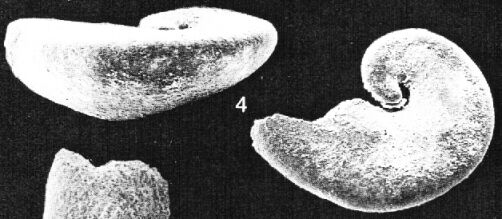
| Paragastropoda | ||
| Mollusca | Pelagiellida |
Paragastropoda
└─► |
|||
None |
Mollusca |
|
Abbreviated Dendrogram
Conchifera
╘═Helcionelloida
└─┬─Paragastropoda
│ ├─Pelagiellida
│ └─Mimospirida
│ ├─Onychochilidae
│ └─┬─Cliospiridae
│ └?─Omphallocirridae
└─┬─Bellerophontoidea (torted)
└─Gastropoda (crown group)
|
Contents
Overview |
Taxa on This Page

The pelagiellids include a single family of small Cambrian snail-like forms of uncertain affinity. They appear in the Atdabanian and have no clear antecedents, and continue through to the Middle Cambrian.
Pelagiellids have been included in the Gastropoda, the "Monoplacophora", as possibly a distinct class of untorted asymmetrical mollusks by Yochelson 1978, and by Linsley & Kier 1984 in the new class Paragastropda. Protoconch studies by Dzik and cladistic analyses by Wagner both link the pelagiellids with the onychochilids [Wagner 2001 p.1130],, and I have therefore considered these small mollusks to be the earliest members of that class, and, following Wagner, an early side-branch in what could be called the "gastropodomorph" clade. Presumably they evolved from Helcionelloid ancestors some time in the early Atdabanian or perhaps Tommotian, and gave rise to Onychochilids shortly before dying out in the middle (or late?) Cambrian.
According to Linsley & Kier 1984, Pelagiellids were "mobile browsers", which indicates they were comparable to true gastropods in this regard. However, Brasier, 1989 p.138 reports that Pelagiella seems to occur widely with a pandemic assemblage close to the appearance of Serrodiscus bellimarginatus or other eodiscid trilobites, possibly indicating a pelagic or epiplanktonic habit.
Whatever the ecology, it is likely that - as with chitons and docoglossa gastropods, their sense organs were very rudimentary, they lacked antennae, only moved slowly, and were most probably confined to hard substratum. Cambrian ecosystems seem to have been fragile and susceptible to mass-extinction, and the Pelagiellids did not survive even to the end of the period. They did however give rise to their more diverse descendents, the Mimospirida
Pelagiella has a cosmopolitan distribution, which indicates either a long planktonic larval stage, or a planktonic or epiplanktonic adult stage. The genus appears suddenly with no clear antecedents (assuming Aldanella is non-molluscan). Various species are widely reported from the late Atdabanian through to Early Botomian of Siberia and equivalent of Shropshire, Nova Scotia, Greenland, Morocco, northern Iran, the Himalayas, and Sichuan in China. [Brasier, 1989 p.138]
Pelagiellida:
Stratigraphic distribution - Atdabanian to Middle Cambrian
Characteristics: Orthostrophic Paragastropoda with elongated apertures
Taxon: Order Pelagiellida
The Order Pelagiellida is here considered the same as the Order Orthostrophina Linsley & Kier 1984 and, one may assume, the Superfamily Pelagiellacea Knight, 1956. Following Yochelson 1978 the Aldanellidae, which Linsley and Kier tentatively include here, are considered non-mollusks (although like the Hyolithida they may be "Molluscomorphs").
Contains: Pelagiellidae
Reference: Linsley & Kier 1984 p.250
Pelagiellidae:
Stratigraphic distribution - Atdabanian to Middle Cambrian
Characteristics: Orthostrophic, right-handed paragastropods with an elongated tangential apertures. Inhalant current entering near umbilical area, frequently marked by a sinus. Exhalant current exiting near periphery of shell and marked by angulation or even a selenizone generating sinus. Shell rather flattened on top and arched below.
Taxon: Family Pelagiellidae Knight, 1956
Genera included Pelagiella Matthew, 1895; Cambretina Horny, 1964; Costipelagiella Horny, 1964; Proeccyliopterus Kobayaahi, 1939.
Reference: Linsley & Kier 1984 p.250
page uploaded 25 February 2003,
last modified ATW060227
checked ATW050720
original material by M. Alan Kazlev all other material © original authors or sources